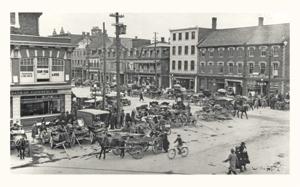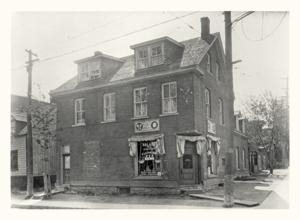
Byward Market, 1922. Credit: City of Ottawa Archives
In 1915, René L was strolling along Clarence St in Ottawa’s Byward Market when he noticed another man. Emery L, who lived at 116 Clarence St, had just finished having his supper in one of the nearby Chinese restaurants. René waited until he was certain Emery had seen him and then ducked into a laneway at 108 Clarence. As René told the court, “I went in to the lane and Emery L followed me.” This turned out not to be such a great idea, for in the busy Byward Market there were always police constables on the beat. According to the constable who discovered the two in the laneway, this is what occurred: “Emery L was sitting on a log in a reclining position and René L was astride of Emery L in the act of working Emery L’s privates with his hand.”
In my first article (“Naked Civil Servants,” Xtra #241, March 15; online at xtra.ca), I used historical criminal court records to look at sexual relations primarily among the civil servants who resided in Ottawa’s Centretown. But sex between men was not restricted to middle-class professionals and their luxury apartment houses. As René and Emery’s story suggests, a lot of homosexual activity occurred as part of everyday life in the city’s immigrant and working-class neighbourhoods.
The Byward Market in Lowertown was a predominantly French and Jewish working-class district. René and Emery’s chance encounter in a Lower-town laneway was only one of many such liaisons. Henry S, who lived at 69 Besserer St, told the court that “the night before last I went to Matthew’s Butcher Shop. I saw the accused Ovila B outside the shop. He said will you come with me? I said where to? He said to my house. He asked me to go to bed with him.” These meet-ups that happened while men were going about their business, be it having dinner in a restaurant or shopping for groceries, underscore the way homosexual encounters were enmeshed in the fabric of everyday life.
To the west of Lowertown, Irish, French and Italian working-class communities grew up in the LeBreton Flats area. Focused on the Chaudière Falls, LeBreton Flats was an industrial district, dotted with sawmills and factories. Again, the court records suggest that homosexual life was rooted in and reflected the broader character of the neighbourhood. Harry C, for instance, lived at 138 Elm St in 1923, and his sexual encounter took place in one of the district’s paper factories.
Both Lowertown and LeBreton Flats played host to the many transient workingmen employed in the seasonal lumber industry. When not living in lumber camps up in the bush, many bushworkers came down to Ottawa for short periods of time. Some men lodged with working-class families who took in borders to supplement their household incomes. The presence of these workingmen and their living arrangements gave a distinct shape to Ottawa’s homosexual subculture.
Not surprisingly, sex between lodgers and other male persons in working-class households was a common scenario. In 1927, 13-year-old Sidney S lived with his parents in a house at 63 LeBreton St. That year Joseph B boarded with the family. In court Sidney was questioned by a lawyer:
Q: Do you know the accused, Joseph B?
Sidney S: Yes sir.
Q: I understand he lodged at your father’s place part of the time?
SS: Yes.
Q: And when he lived there what room did he occupy in the house, or did anybody else occupy the same room as he did?
SS: Yes, sir, I did.
Q: Was there just the one bed in the room?
SS: Yes.
Q: And you sometimes slept with him in that bed?
SS: Yes.
Q: Now, did anything ever take place between him and you that should not have taken place?
SS: Yes.
Q: What was that?
A: He always fooled with my privates.
Obviously having little knowledge of working-class life, the lawyer asked Sidney, “Why did you go back to sleep with him on occasions after the first time this happened; you knew what he was doing to you. Why didn’t you go to sleep some place else?” “I could not,” replied Sidney, “all the beds were occupied in the house. There was only that bed.” In the early part of the 20th century, in what were often crowded working-class households, it was a common practice to double up.
Doubling up placed some children in a potentially dangerous position as the objects of unwelcome sexual advances by male lodgers. At the same time, other boys found ways to turn their sexual vulnerability and cramped sleeping arrangements at least somewhat to their advantage. When Sidney was asked whether he ever told anyone about having sex with Joseph, he responded, “I did not say anything about it.” “Why not?” asked the perplexed lawyer. “He used to give me things, cigarettes and things.”
While some men boarded with individual families, other men set themselves up in all-male rooming houses. With little money and no plans to stick around for long, a crowded, often rundown rooming house was one of the few options available to many immigrant and working-class men. Not surprisingly, under such conditions privacy was hard to come by.
In 1915, three Austrian men were among those who lived in a rooming house in Lowertown. As Peter B told the court, “I live at 144 Besserer St. I know both Kosyn B and Oscar M. We were all in one bedroom. I was in the bedroom there that day with Oscar. He asked me to leave the room and he would have fun with Kosyn. Oscar pulled me by the hand and I left the room. After I left the room I looked through the door. Kosyn had his trousers down. Oscar had his shirt and his trousers open. Kosyn was lying on his face and Oscar was on top of Kosyn working himself up and down. Oscar told me before I left the room that he would use Kosyn in the way I saw him do so.”
While the case testifies to the potentially disastrous results of lacking privacy (and trusting your friends), the way Oscar felt free to ask Peter to leave the room so he could have some fun with Kosyn suggests there existed a rather frank understanding of sexual relations between men. The case file also noted that the court proceedings were conducted with the assistance of an “Austrian Interpreter,” a reminder that, in addition to the ordeal of a trial on homosexual charges, immigrant men faced additional barriers of language.
All of these cases remind us of an important point about queer men’s history. Much gay historical writing focuses on elite or famous (most often Anglo-Saxon) men, those who were educated and inclined to write down the stories of their lives in letters and diaries, or who were important enough to be the subjects of newspapers and biographies. As a result, we know much more about Oscar Wilde than we do about Oscar M of Lowertown. Hopefully, however, these brief forays into the past highlight the contributions of more ordinary men — the workingmen and immigrants who helped to forge homosexual subcultures in early 20th-century Ottawa.

 Why you can trust Xtra
Why you can trust Xtra


